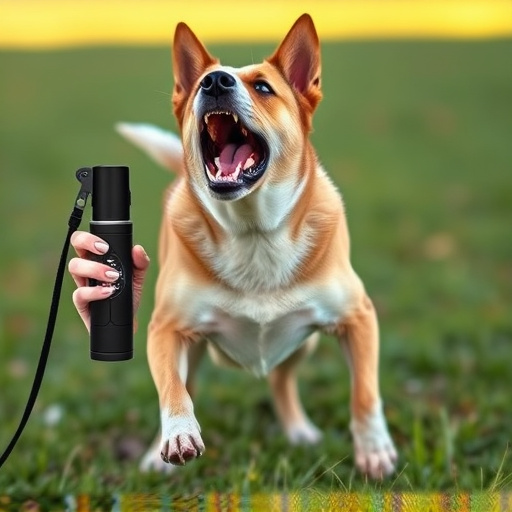Dog pepper spray (mace spray) is a powerful tool for animal control, but its use in many US states is heavily restricted due to health risks and misuse concerns. Understanding local laws, active ingredients, application methods, and side effects is crucial for responsible usage. Purchase and deployment considerations should be made with care, especially in regions where civilian use is banned or highly regulated, such as the Dog Pepper Spray Restricted States. Sustainable alternatives like capsaicin repellents, noise deterrents, visual aids, and strategic landscaping are gaining popularity as chemical-free options.
“Unleashing control over unruly animal encounters, mace spray emerges as a powerful tool in the realm of animal deterrence. This comprehensive guide delves into the intricacies of dog pepper spray, shedding light on its effectiveness and legal landscape, especially highlighting Dog Pepper Spray Restricted States.
From understanding the principles behind its operation to exploring alternatives and safety protocols, we navigate the crucial aspects of mace spray use. Whether you’re a professional or a concerned pet owner, this article ensures you’re equipped with knowledge in light of the ever-evolving regulations surrounding Dog Pepper Spray Restricted States.”
- Understanding Mace Spray for Animal Control: An Overview
- Dog Pepper Spray: Legal Considerations and Restricted States
- Alternatives to Chemical Sprays for Animal Deterrence
- Safety Precautions and Responsible Use of Mace Spray
Understanding Mace Spray for Animal Control: An Overview
Mace spray, also known as dog pepper spray, is a controversial yet effective tool used for animal control, particularly in managing aggressive dogs. It’s a type of self-defense aerosol designed to temporarily incapacitate an attacker by causing irritation and burning sensations in the eyes, nose, and throat. When deployed, the spray creates a cloud of oleoresin capsicum (OC), a natural chemical compound derived from chili peppers, which can deter and control unwanted animal behavior.
While highly effective, dog pepper spray comes with restrictions and considerations. Its use is regulated by various states due to potential health risks and misuse concerns. Some states have implemented strict guidelines and even banned it entirely for civilian use, particularly in areas where there are no specific training requirements or oversight mechanisms. It’s crucial to understand the legal implications and responsible usage of mace spray, especially when considering its purchase and deployment for animal control purposes. Additionally, understanding the active ingredients, application techniques, and potential side effects ensures safe and effective management of aggressive animals without causing unnecessary harm.
Dog Pepper Spray: Legal Considerations and Restricted States
Dog pepper spray, also known as dog repellent or canine control spray, is a popular tool for animal control and deterring aggressive dogs. However, its use comes with legal considerations, especially regarding restrictions on where and how it can be employed. The legality of dog pepper spray varies significantly across different states in the US, with some states having strict regulations in place to ensure safe and responsible usage.
In many restricted states, dog pepper spray is only permitted for use by authorized individuals, such as law enforcement officers or trained animal control professionals. These states often have stringent guidelines on the type of spray allowed, its concentration, and the circumstances under which it can be deployed. For instance, some states prohibit the use of pepper spray against dogs in residential areas or during hunting activities. It’s crucial for dog owners and handlers to understand these restrictions before considering dog pepper spray as a control measure, ensuring they remain compliant with local laws to avoid legal repercussions.
Alternatives to Chemical Sprays for Animal Deterrence
Many regions have placed restrictions on the use of chemical sprays, particularly dog pepper spray, due to safety concerns and potential environmental impact. These bans highlight a growing trend towards more sustainable and non-lethal animal deterrence methods. One alternative gaining traction is the use of natural repellents derived from plants. For instance, capsaicin, the compound that gives chili peppers their heat, has been shown to effectively ward off wildlife like squirrels and raccoons without causing harm.
Additionally, noise deterrents such as motion-activated sprinklers or ultrasonic devices can be effective in scaring away animals. Visual deterrents like reflective tape, motion-detecting lights, and even specific patterns of landscaping can also help keep unwanted critters at bay. These methods not only avoid the use of chemicals but also promote a more harmonious coexistence between humans and wildlife.
Safety Precautions and Responsible Use of Mace Spray
When using mace spray for animal control, safety should always be the top priority. It’s crucial to understand that dog pepper spray, also known as mace spray, is a powerful tool designed for self-defense against aggressive animals. However, its use comes with significant risks and potential legal repercussions, especially due to varying restrictions across different states. Before deploying any type of pepper spray, users must be aware of local laws and regulations regarding its possession, carrying, and use—with particular focus on Dog Pepper Spray Restricted States.
Responsible use involves adhering to manufacturer guidelines and ensuring the safety of both the user and targeted animals. This includes wearing protective gear, aiming carefully, and using only as much force as necessary to de-escalate or deter an encounter. Improper or reckless use can result in injury, particularly to vulnerable individuals or animals with pre-existing conditions. Additionally, it’s important to store mace spray securely, out of reach of children and unauthorized persons, to prevent accidental deployment or misuse.
In conclusion, while dog pepper spray can be an effective tool for animal control, it’s crucial to understand its legal limitations, especially in those states that restrict its use. Alternatives exist for deterring animals without resorting to chemical sprays, and safety precautions must always be prioritized when considering any form of animal control method. Staying informed about local regulations and choosing the right approach based on specific needs can help ensure humane and responsible animal control practices.
